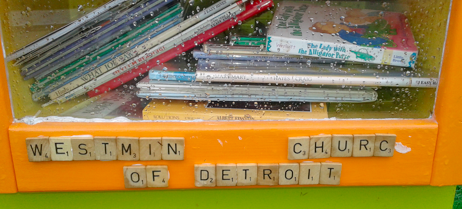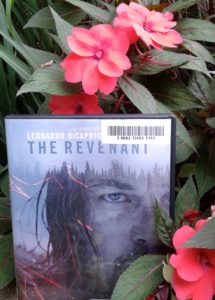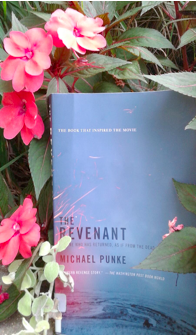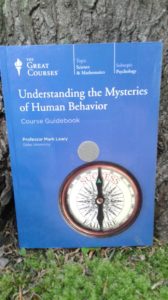Westminster Church serves and delivers turkey dinners to the hungry. On Thanksgiving morning, Detroit police, mostly older and maybe even retired, load large quantities of food into the trunks of their police cruisers. Beyond the curbside cars, two lines form–one to eat and one to serve. I join the serving line and notice a hunger for reading served with two Little Free Libraries by the sidewalk. Inside the church, orange table clothes, festive center pieces and individual Thanksgiving cards drawn by children adorn tables decorated for today.
My Just Deserts
Volunteers are directed to the kitchen, meal delivery or wait staff. My son and I are assigned to packaging desserts and must wear plastic trash bag-like aprons. We stand in the doorway to the unheated dessert room and inhale the scents of the season–cinnamon, nutmeg, cloves and chocolate. This room houses thousands of single-serving Styrofoam containers stacked on trays in carts towering from floor to ceiling and front to back–more Styrofoam than I’ve ever seen in one place. Our work today is the culmination of days of preparation.
Is There an APP for This?
Our first orders are for quantities of 218, 63, 42, 28, several threes and several twos. Notes taped to each cart indicate the quantity–196 on this one and 360 on another with some trays already removed or partially emptied. We multiply and find a standard thirty-six per tray. Several pre-packed boxes bare labels for fifty-four, eighteen and then varying amounts of whatever number fit into whatever random box was available. We pack eight desserts in plastic bags and combine boxes with bags to fill the orders. Who knew there would be so much math? Then, we lose track of our count and have to start over. On holiday, our brains weren’t caffeinated enough for mental work. We resort to staging our orders–gather the quantity, pack the nearest cardboard box and label before we forget. It would be terrible to short change an order and accidentally leave out dessert.
An Accidental Milkshake
During our shift, we witness many dinners served–most bundled for delivery to the homebound. We are a tiny piece of a big operation at Westminster Church of Detroit. On our way home, we pass several open restaurants before deciding to stop for a hamburger. This is the coincidence, KARMA or “one good turn deserves another” part of the story. As our order is bagged, an employee sets a milkshake next to the tray and says it was made by mistake. “Do you want it?” My son and I–who spent the entire morning surrounded by desserts–realize we forgot to order dessert. The accidental milkshake feels much bigger than an accidental dessert and more symbolic of “just deserts.” My son rolls his eyes at my speculations and changes the topic. It is all connected. We find cause in coincidence, correlation in chaos and hope in desperation. When hungry and tired, as many are, accidental is welcome, and charitable is divine.




